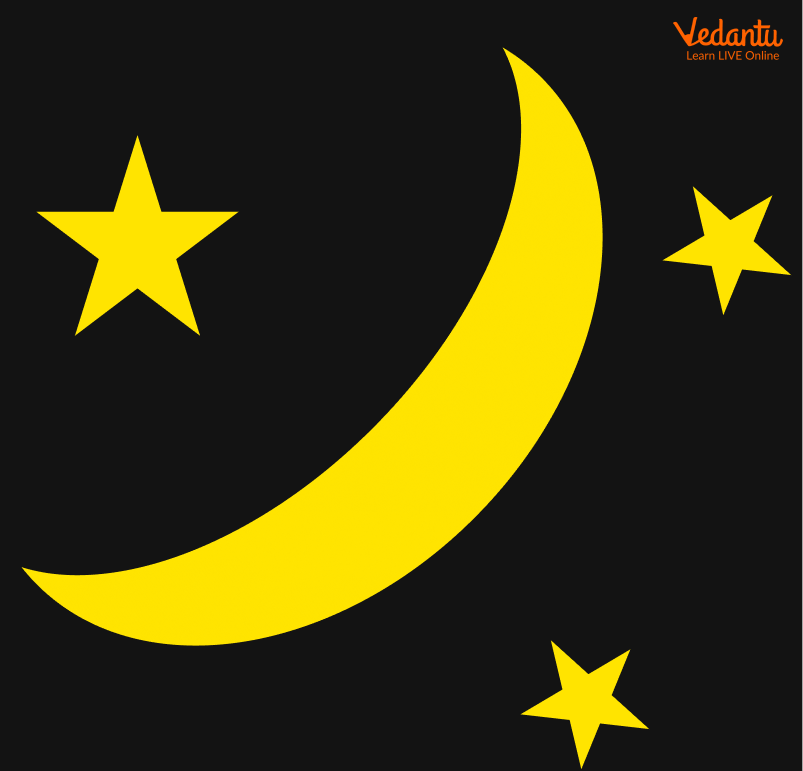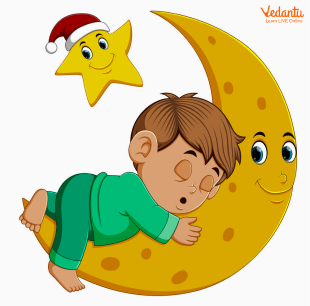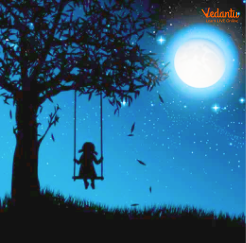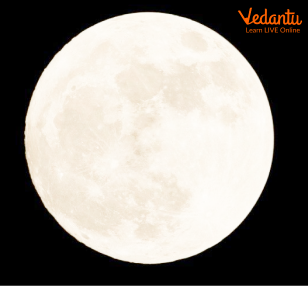Short Kids Poems on Moon
Have you ever wondered what it would be like to explore the gleaming Moon in the sky? Well, it is called the queen of the night as it guides us with its soothing beams in the dark of night. Often elders recite and sing many poems on the Moon to children, and the little ones are fascinated by the Moon. So here are some amusing poems that will take you on a journey to explore the beautiful Moon sliding through the dreamy clouds and a star-studded dark sky of the night.

Image of the Moon
Moon Poems for Kids in English
The Moon
The moon has a face like the clock in the hall;
She shines on thieves on the garden wall,
On streets and fields and harbour quays,
And birdies asleep in the forks of the trees.
The squalling cat and the squeaking mouse,
The howling dog by the door of the house,
The bat that lies in bed at noon,
All love to be out by the light of the moon.
But all of the things that belong to the day
Cuddle to sleep to be out of her way;
And flowers and children close their eyes
Till up in the morning the sun shall arise.
– Robert Louis Stevenson
A Brief Summary of the Poem – The Moon
The poet Robert Louis Stevenson personifies the Moon in this poem. He beautifully captures all the activities that the Moon does while shining through every night. The Moon has a round shape just like a clock. It watches over the thieves on the garden wall. It looks over the sleeping birds, the squalling cat, the squeaking mouse, the howling dog, and the bats that fly out in the night.
As it watches over all the creatures out in the dark, the Moon casts its soothing beams over the beautiful flowers and the little children cuddle asleep in the night.
Let’s All Go To The Moon
We once sang a sweet song in the merry month of June,
“Oh Come With Me To The Valley Of The Moon!”
We shall travel about in clothes of golden sand,
If you will just give me your precious little hand.
Oh come now, let's go to the moon!
In those shaded craters, we shall forever swing,
From a beautiful hand-stitched hammock that I thought to bring!
Can you come with me to the valley of the moon?

A funny image of the Moon
In the sands of shining gold, we’ll all happily dance,
Where only sunbeams and angels have pranced!
We will sit about in the cool shade and shadows,
Eating manna from the fairies in the valleys!
Oh please now come to the moon!
Oh..can you see…there,
My dear child, oh look!
Where the old man’s left eye is, we will be!
All of us forever merry, like a portrait in a book!
Oh please now, let's go to the moon!
Yes you, yes me,
All of us and the whole family,
Do come now, let's go away soon!
– H. G. Dowless
Summary
In this poem, the poet recollects a sweet song that they once sang in the month of June. The song was about their journey to the Moon. He refers to the Moon as a beautiful valley. He asks a child to go to the Moon with him. He says they will be draped in clothes of golden sand. He asks for the little hands of the precious one to take him to the Moon. They will swing in a beautiful hand-stitched hammock in the craters of the Moon.
He describes the valley of the Moon to be filled with gleaming gold, where only angels and sunbeams must have pranced. When they will reach the valley of the Moon, they will enjoy its cool shade. He says the fairies will offer them the miraculous manna in the valley of the Moon.
The poet wishes to take the child and the whole family to the Moon and be like a merry portrait as if it belonged to a book. So, he hurries the child to go away to the dreamy land of the Moon.

Image of the Moon
The Moon
The moon was but a chin of gold
A night or two ago,
And now she turns her perfect face
Upon the world below.
Her forehead is of amplest blond;
Her cheek like beryl stone;
Her eye unto the summer dew
The likest I have known.
Her lips of amber never part;
But what must be the smile
Upon her friend, she could bestow
Were such her silver will!
And what a privilege to be
But the remotest star!
For certainly her way might pass
Beside your twinkling door.
Her bonnet is the firmament,
The universe her shoe,
The stars the trinkets at her belt,
Her dimities of blue.
– Emily Dickinson
Summary
The poem has a very warm and light-hearted theme. The poetess has used figurative language to describe the beautiful Moon. She admires the Moon and says that it resembles a chin of gold. She compares the Moon with a beautiful woman and describes its parts by drawing various comparisons.
She says the Moon has a blushing glow, much like the beryl stone that occurs in yellow, blue, pink, or green. She describes the Moon as an ever-smiling face, as its amber lips never part. The amber lips symbolise a warm glossy gold tone that defies the darkness.
She says though the Moon looks like a remote star, it may pass through the twinkling stars beside our homes. The poetess compares the Moon with a woman’s face and the sky with the hat tied around it. She says the Moon wears the stars at her belt and is clad in the blue star-studded sky like a striped drape clads a woman.

Image of the Moon for kids
A Full Moon Is Like You
A full moon is like you and me,
One half for you the other for me
A full moon is like moon cheese,
Yes, yes, yes, I love moon cheese
A full moon is like a dinner plate,
With chocolate pudding and strawberry cake
A full moon is like you and me,
Together let’s have moon glee.
Summary
In the above poem, the poet has described the Moon in wonderful ways. As we can see the Moon from several places, the poet says one half of the Moon is for him while the other half is for us. He describes the Moon as his favourite snack, the Moon cheese. Furthermore, he compares the white round Moon with a dinner plate loaded with delectable desserts like puddings and cakes. Overall, the poet expresses his fondness for the Moon through this poem.
Some Interesting Facts about the Moon
The Moon completes one revolution around the Sun in 27 days.
We can only see nearly 60% of the Moon.
It is the second brightest object after the Sun, in our solar system.
There are mountains on the Moon, the tallest of which is called Mons Huygens.
Neil Armstrong was the first man to step on the Moon.
The English rhymes and poems on Moon, Sun, and nature are quite helpful to introduce these celestial bodies and the components of nature to young kids. In fact, the rhyming words of the poems make it all the more interesting for kids to learn about these new things. Vedantu provides easy rhymes and poems in English on various topics and objects. So, check all of them out to provide your kids with a wonderful learning experience.


FAQs on Rhyme Poems on Moon in English for Kids
1. List 5 poems for kids on the Moon.
The following are the five popular poems on the Moon.
The Moon
The New Moon
Up High the Moon
I think the Moon is very kind
Moonlight
2. Why is the Moon called the natural satellite of the Earth?
The Moon is the only natural satellite of the Earth. A satellite is generally smaller than the planet or celestial body that it moves around. The Moon is called the Earth’s natural satellite because it orbits around the Earth just like a satellite is designed to orbit around a planet in a particular path.





